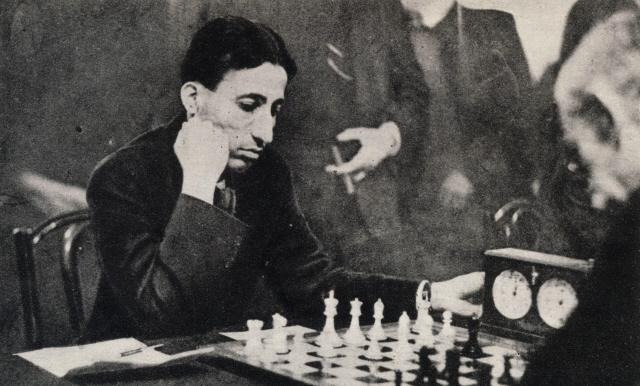Chess
Notes
|
| First column | << previous | Archives [60] | next >> | Current column |
6197. Who?
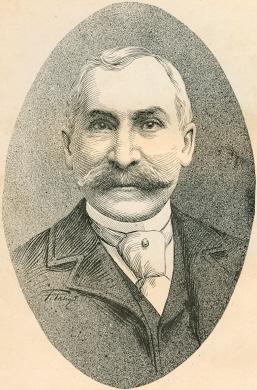
Identifying this chess writer (he authored two books on the game) may prove especially difficult.
6198. Masters’ reports on simultaneous displays
Nigel Short (Athens) asks for striking examples of magazine reports by leading masters on their simultaneous displays. Of particular interest will be reflective accounts, rather than the mere chronicling of results.
6199. Postage stamps
We note further postage stamps issued by Cuba in 2008 which feature Capablanca:
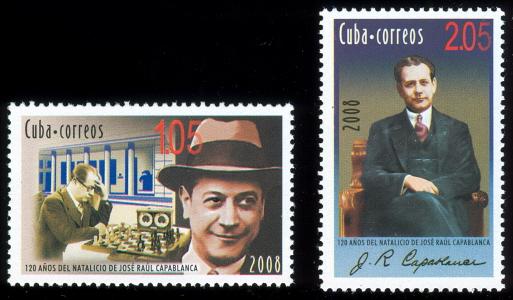
The well-known shot of Capablanca at the board was published on page 414 of CHESS, 14 July 1936:
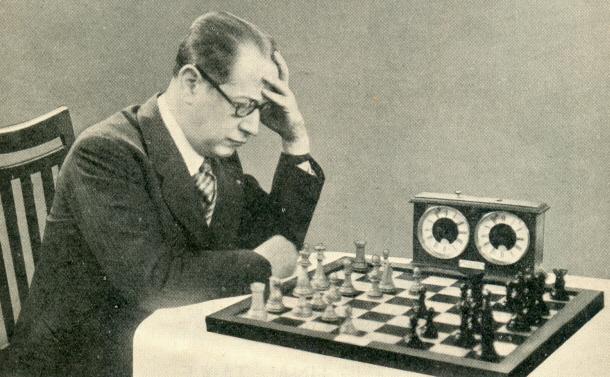
6200. Mr and Mrs Piatigorsky (C.N.s
5432, 5436 & 5443)
Jules Welling (Best, the Netherlands) is seeking games played by either Gregor or Jacqueline Piatigorsky.
Assistance from readers will be appreciated. A brevity won by Jacqueline Piatigorsky against Mrs W.W. Owens was given in C.N. 5436, from page 23 of the January 1952 Chess Review.
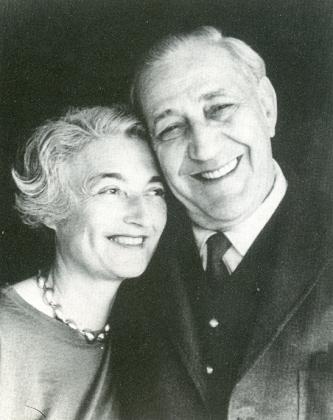
Jacqueline and Gregor Piatigorsky (source: the former’s autobiography, Jump in the Waves)
6201. Miss Fatima
For the book on Indian chess history mentioned in C.N. 6152 Manuel Aaron (Chennai, India) would like information on Miss Fatima, who won the 1933 British Ladies’ Championship in Hastings by a margin of three points.
We raised the subject in C.N. 14, but even basic biographical details about her are still lacking. She had also participated in the previous year’s championship, finishing sixth, and page 381 of the September 1932 BCM reported:
‘... additional interest was imparted by the entry of Miss Fatima, from India, who has had the advantage of some instruction from Sultan Khan and other chessplayers on Sir Umar Hayat Khan’s staff.’
The following passage appeared on page 424 of the October 1932 issue:
‘Miss Fatima made a very good first appearance in the event. She is only 18, has never played in a tournament before, and very little in public at all. The experience should give her confidence; and she has been well taught.’
Page 375 of the September 1933 BCM commented:
‘Miss Fatima was clearly the strongest and cleverest, as the fact of her being able to recover from quite a number of “lost” positions showed. She has had coaching from Miss Menchik, while Dr Bassalvi also has given her a good deal of practice. There is only room to give a specimen of her capital end-play.’
The position was from her win as White against Mrs Stevenson:
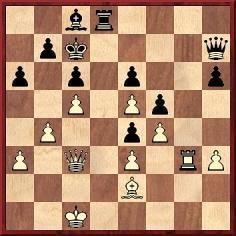
30...Rg8 31 Rxg8 Qxg8 32 Qd4 Qd8 33 Qd6+ Qxd6 34 exd6+ Kd7 35 Bc4 b5 36 Bb3 Ke8 37 Kd2 Kf7 38 Kc3 Kf6 39 Kd4 Bd7 40 Bd1 Be8 41 h4 Bf7
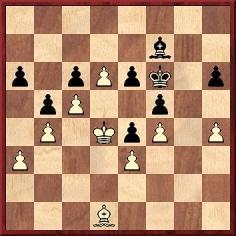
42 d7 Ke7 43 Ke5 Kxd7 44 Kf6 Be8 45 Bb3 Kc7 46 Bxe6 and wins.
Miss Fatima was interviewed about Sultan Khan in the
Bandung Limited television production The Sultan of
Chess broadcast by Channel 4 in the United Kingdom
on 19 September 1990. She mentioned that she had given
some chess instruction to Queen Mary, the wife of George
V.
6202. Nabokov
From John Roycroft (London):
‘The fifth line of the first of Vladimir Nabokov’s trio of linked sonnets (1924) on composing a chess problem reads: “Там Филидор сражался и Дюсер”. It is not clear if, or if so how, Дюсер is to be transliterated. However one treats it, the name is quite unfamiliar in the context of Philidor. One seems forced to conclude that Nabokov invented it, though a remote possibility is an obscure musical connection.
Can anyone shed light?’
6203. Bogoljubow in Zurich
Noting that Bogoljubow played in a small tournament in Zurich in 1946, Adrian Mikhalchishin (Lviv, Ukraine) asks whether any of his games from the event are known.
Bogoljubow’s loss to Adolf Staehelin was given on pages 144-145 of the Schweizerische Schachzeitung, September 1946:
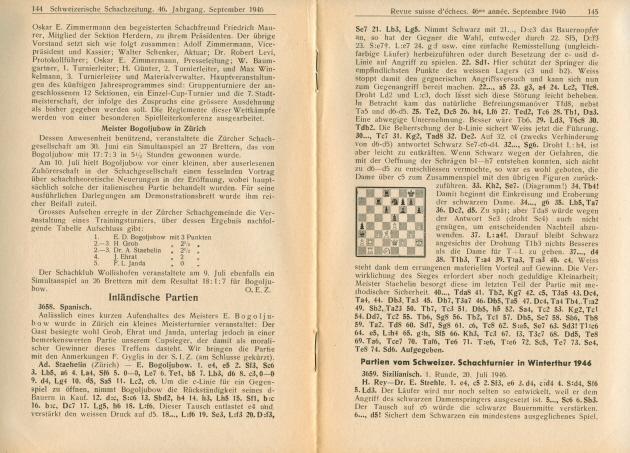
The score is also on page 362 of Schachgesellschaft Zürich 1809 bis 2009 by Richard Forster (Zurich, 2009), and Mr Forster has sent us Bogoljubow’s third-round game:
Efim Bogoljubow – Henry GrobZurich, 1 July 1946
Hungarian Defence
1 e4 e5 2 Nf3 Nc6 3 Bc4 Be7 4 d4 exd4 5 Nxd4 d6 6 Nc3 Nf6 7 f3 O-O 8 Be3 Bd7 9 Qd2 a6 10 Nxc6 Bxc6 11 O-O b5 12 Bb3 Bb7 13 Ne2 c5 14 c3 Qc7 15 Nf4 Rad8 16 Nd5 Nxd5 17 Bxd5 Kh8 18 Rad1 f5 19 Bxb7 Qxb7 20 exf5 Rxf5 21 Rfe1 Rdf8 22 Bf2 d5 23 Re6 Bg5 24 Qd3 Qf7 25 Rxa6 c4 26 Qf1 Bf4 27 Re1 Qc7 28 h3 Qc8 29 Ree6 Bb8 30 Qe2 b4 31 cxb4 Qc7 32 Kf1 c3 33 bxc3 Qxc3
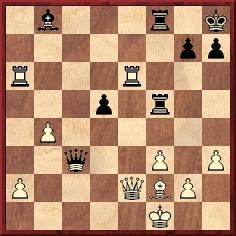
34 Rac6 Qxb4 35 Qd3 Qf4 36 Be3 Qb4 37 a3 Rxf3+ 38 gxf3 Qh4 39 Qf5 Qd8 40 Bb6 Rxf5 41 Bxd8 Rxf3+ 42 Ke2 Rf8 43 Be7 Rg8 44 Bc5 Resigns.
Sources: Tat, 6 July 1946 and Henry Grob’s score-sheet.
6204. Capablanca photograph (C.N. 6199)
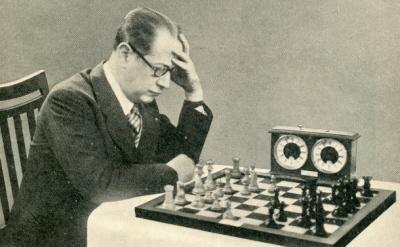
Nick Pinkerton (Bracknell, England) notes that the board position arose in Capablanca’s first-round game against P.S. Milner-Barry at Margate, 1936. The absence of a score-sheet may suggest that the picture was staged, but we have no further information. The game was given on pages 333-334 of CHESS, 14 May 1936 accompanied by a sketch:
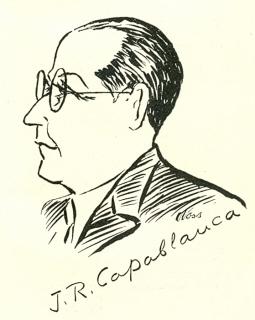
6205. Mac Orlan
Martin Weissenberg (Savyon, Israel) refers to the remark ‘il y a plus d’aventure dans une partie d’échecs que sur toutes les mers du monde’ on page 81 of the novel L’Ancre de Miséricorde by Pierre Mac Orlan (Paris, 1941). For the context we reproduce the extract below:
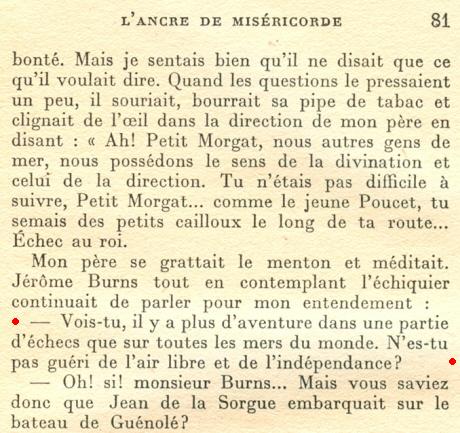
6206. Incorrigible

Page 10 of Learn from Bobby Fischer’s Greatest Games by Eric Schiller (New York, 2004)

Page 12 of Learn from Bobby Fischer’s Greatest Games by Eric Schiller (Las Vegas, 2009)
6207. Ramiro Capablanca
The only Capablanca mentioned (briefly) in the 1696-page book Cuba The Pursuit of Freedom by Hugh Thomas (New York, 1971) was Ramiro, who joined the country’s government in 1933 as Secretary of the Cabinet. As mentioned on page 317 of our monograph on J.R. Capablanca, there was a biography of Ramiro, his brother, on pages 77-78 of volume nine of Diccionario Biográfico Cubano by Fermín Peraza Sarausa. For the record, we reproduce it here:
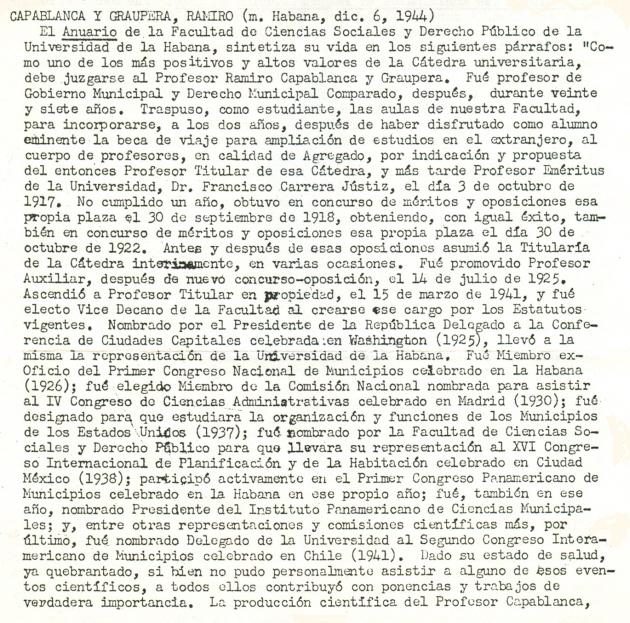
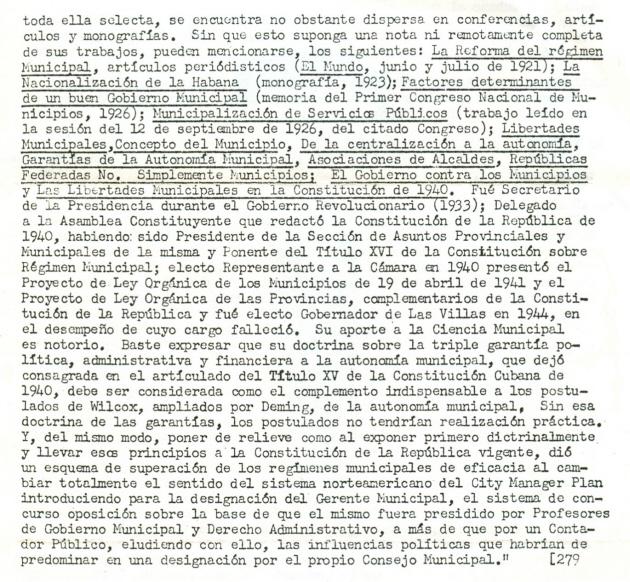
6208. Miss Fatima (C.N. 6201)
Jan Kalendovský (Brno, Czech Republic) draws attention to two victories by Miss Fatima on page 244 of L’Echiquier, 6 October 1933:
Mrs Edith Mary Ann Michell – Miss FatimaHastings, 1933
Queen’s Gambit Declined
1 d4 Nf6 2 e3 e6 3 Bd3 d5 4 Nf3 Nbd7 5 O-O Bd6 6 c4 c6 7 Nc3 O-O 8 e4 dxe4 9 Nxe4 Nxe4 10 Bxe4 Nf6 11 Bc2 h6 12 Qd3 Qc7 13 Re1 Rd8 14 Qc3 c5 15 dxc5 Bxc5
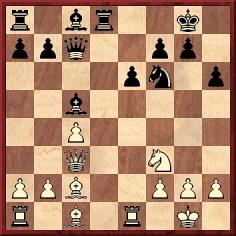
16 Bxh6 Bxf2+ 17 Kxf2 Ng4+ 18 Kg1 Nxh6 19 Ne5 f6 20 Ng6 Ng4 21 Qh3 Qc5+ 22 Re3 Qxe3+ 23 Qxe3 Nxe3 24 Bb3 Rd2 25 Nh4 Rd4 26 Nf3 Rg4 27 g3 Nxc4 28 Re1 b5 29 Kf2 Kf7 30 h3 Rg6 31 Re2 Bb7 32 Nd4 Rg5 33 Nxe6 Rf5+ 34 Kg1 Re8 35 Nxg7 Rxe2 36 Nxf5 Kg6 37 g4 Rg2+ 38 Kf1 Nd2+ 39 White resigns.
Miss Fatima – Mrs Amy Eleanor WheelwrightHastings, 1933
King’s Indian Defence
1 d4 Nf6 2 c4 g6 3 Nf3 Bg7 4 Bf4 d6 5 e3 O-O 6 h3 Nh5 7 Bh2 f5 8 Bd3 Nc6 9 Nc3 Nf6 10 a3 e6 11 Rc1 Qe7 12 O-O e5 13 dxe5 dxe5 14 Be2 Kh8 15 Nd5 Nxd5 16 cxd5 Nd8 17 b4 Qd6 18 Qb3 Bd7 19 Qc3 f4
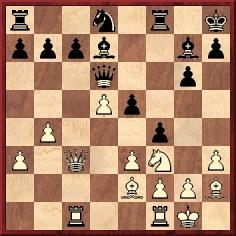
20 Qxc7 Qxd5 21 Rfd1 Qa2 22 Rxd7 Qxe2 23 Rxg7 Ne6 24 Rxh7+ Kg8 25 Qxe5 Kxh7 26 Qxe6 Qb2 27 Rc7+ Kh8 28 Bxf4 Rxf4 29 exf4 Qa1+ 30 Kh2 Qd4 31 Nxd4 Resigns.
6209. Who? (C.N. 6197)
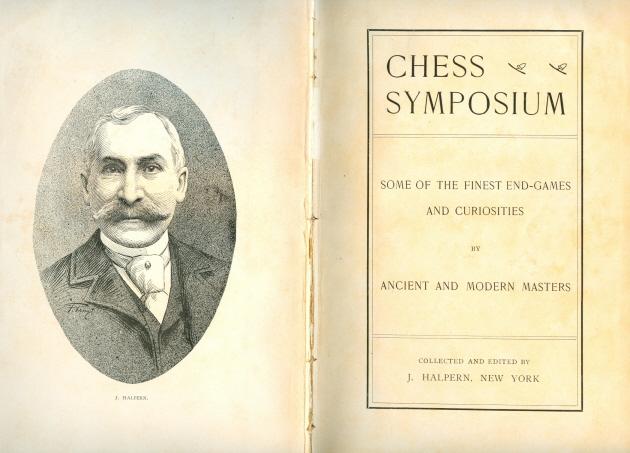
The sketch in C.N. 6197 was the frontispiece to volume one of Chess Symposium by J. Halpern (referred to as Halpern’s Chess Symposium on the front cover). Standard bibliographical sources say that it was published in 1904, and that date was given by Olimpiu G. Urcan (Singapore) in C.N. 6176. However, Mr Urcan now notes that the book was briefly reviewed on pages 467-468 of the November 1902 BCM.
Thus Douglas A. Betts’ Bibliography, to name but one source, was also incorrect to state that volume one of Chess Symposium was published by the American Chess Bulletin, which was not founded until 1904. Volume two, though, was published by the Bulletin, in 1905:
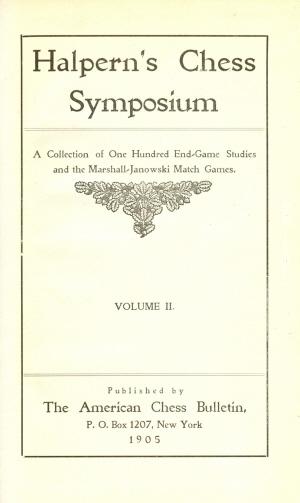
6210. Keres and Philidor
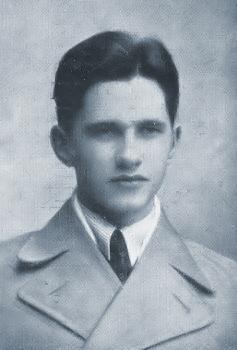
Paul Keres
Chris Eve (Victoria, BC, Canada) mentions a citation on the back cover of Grandmaster of Chess The Complete Games of Paul Keres by P. Keres (New York, 1972):

We note that clarification of the ‘anachronism’ is supplied by the back cover of the original edition (London, 1969) of the third volume in the series:

The full text of the Spectator article by ‘Philidor’ would be appreciated.
6211. Street names
In C.N. 725 (see page 106 of Chess Explorations) a correspondent quoted this item from page 91 of Chess World, April 1952:
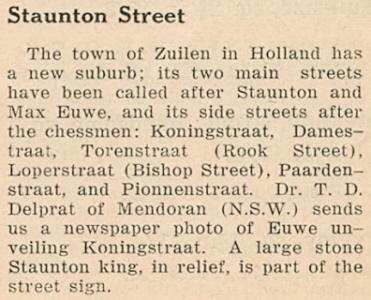
Now, though, Henk Smout (Leiden, the Netherlands) points out that Chess World was misinformed about the names of the side-streets, i.e. Pionstraat, Paardensprongstraat, Schaakstraat, Simultaanstraat, Rokadestraat, and Grootmeesterplein.
Through a search for any of the streets on Google maps the locality is readily found:
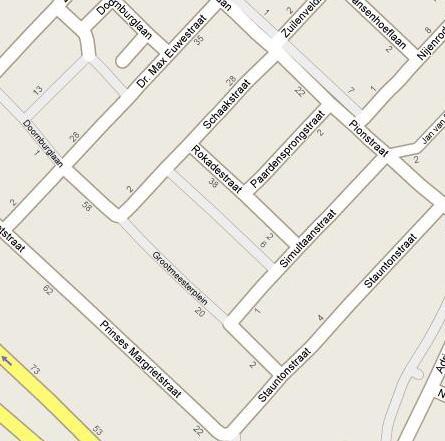
Our correspondent adds:
‘Max Euweplein in Amsterdam, Max Euwelaan in Rotterdam, Max Euweweg and Jan-Hein Donnerstraat in The Hague are all named after the masters.
Reestraat, Koningstraat, Koninginnestraat, Paardenstraat, Torenstraat, Kasteelstraat, Kastelenstraat, Loperstraat, Raadsherenstraat, Bisschopsplein in Zuilen and Bisschopsstraat in a number of Dutch and Belgian places have nothing to do with chess.’
6212. Grover
Our latest Chess Explorations article at ChessBase concerned hype in chess books and gave examples of various kinds, up to and including outright mendacity. Frederick S. Rhine (Park Ridge, IL, USA) expresses particular interest in the case of Kenneth M. Grover, and we therefore reproduce below not only the text of C.N. 2345 (see pages 285-286 of A Chess Omnibus) but also the full references to Grover in the books mentioned:
The dust-jacket of Chess by K.M. Grover and T. Wiswell stated: ‘Kenneth M. Grover, when 12 years old, was hailed as a chess child-prodigy, and today he is America’s number-one chess player.’ The original (1941) US edition called him ‘America’s Number One chess and checker exhibition player’. In their other books, Let’s Play Checkers (New York, 1940) and Twentieth Century Checkers (Philadelphia, 1946), the twosome also awarded themselves high-pitched write-ups. The back-cover of the former said of Grover: ‘He is America’s No. 1 checker and chess exhibition star and is popularly known as the “Mighty Mite”.’
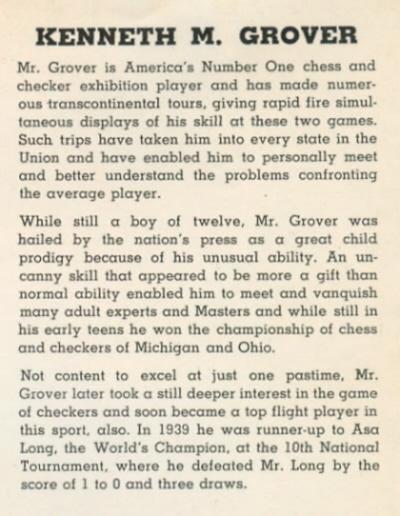
Chess by K.M.
Grover and T. Wiswell (New York, 1941)

Chess by K.M. Grover and T. Wiswell (London, 1952)
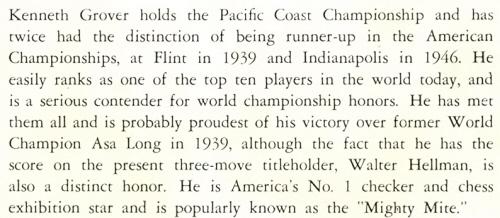
Let’s Play Checkers
by K.M. Grover and T. Wiswell (New York, 1940)
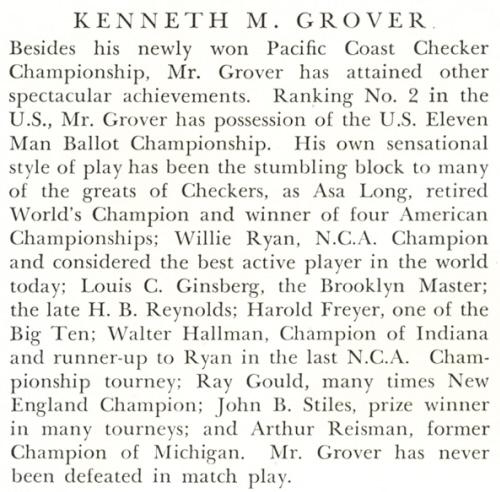
Twentieth Century Checkers by K.M. Grover and T. Wiswell (Philadelphia, 1946)
Below is the frontispiece to Twentieth Century Checkers:
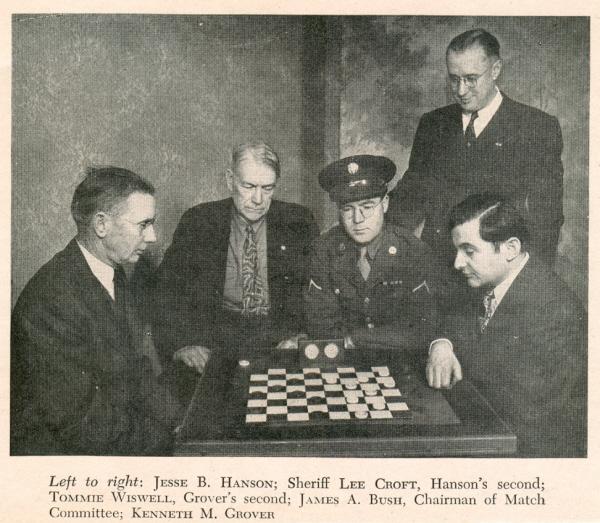
6213. Different editions
Bill Kiplinger (Hacienda Heights, CA, USA) reports that he has a hardback copy of Fischer’s My 60 Memorable Games which, despite being dated 1969 and indicating ‘First printing’ on the imprint page, has, on its dust-jacket, a table of Fischer’s playing record which extends to the 1971 match against Petrosian.
Our collection also contains that edition. Was ‘First printing’ an error, or did Simon and Schuster, in the early 1970s, place a new dust-jacket on its unsold stock of the original 1969 volume?
6214. Faber and Faber
From page 287 of Bobby Fischer Uncensored by David and Alessandra DeLucia (Darien, 2009) we reproduce a note by Fischer dated 8 July 1999:
‘The Jews claim that I’m mentally ill but they’re the ones who are mentally ill. What terrible hatred inside of them compelled them to forge an illegal mating variation in the Batsford edition of “My 60 Memorable Games” in my game with Bolbochan. And in the 1988 Faber and Faber edition of “My 60 Memorable Games” what compelled them to forge “winning the Bishops pawn” rather than what I really wrote “winning the two Bishops”. They’re the ones who are mentally ill!!!’
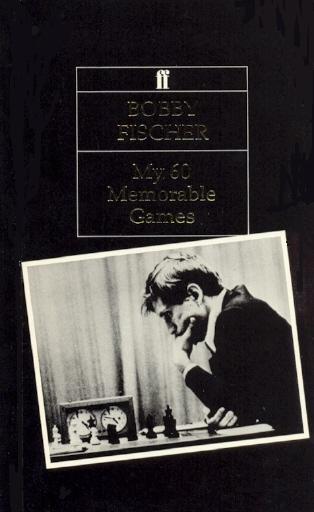
The Faber and Faber edition ‘Reissued 1988’
Page 288 of Bobby Fischer Uncensored has a note by Fischer dated 6 August 1999:
‘Notice I wrote “winning the two Bishops” not “winning two Bishops”. “Winning the two Bishops” is chess lingo for gaining the theoretical advantage of having two Bishops versus your opponent’s Bishop and a Knight. Faber and Faber understood this perfectly well.’
C.N. 4867 referred to textual discrepancies relating to the 1988 Faber and Faber edition. Who in that company made changes to Fischer’s text, and why?
6215. Keres and Philidor (C.N. 6210)
From Leonard Barden (London):
‘“Philidor” was C.H.O’D. Alexander. The Sunday Times, where he wrote under his own name, objected to him writing what it considered a rival column; hence the pseudonym.’
6216. Spot the master
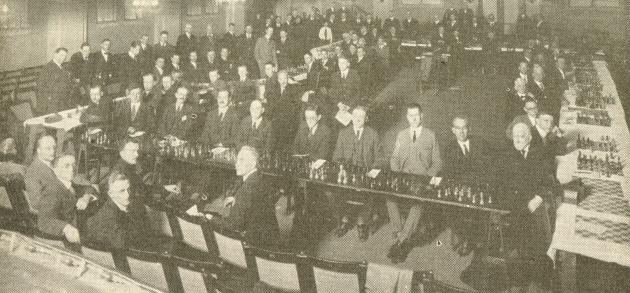
6217. MacCutcheon/McCutcheon
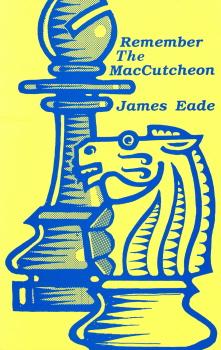
Oliver Beck (Seattle, WA, USA) draws attention to this passage on page 3 of Remember The MacCutcheon by James Eade (Moon Township, 1991):

In addition to ‘Bogolubow’, ‘Capablance’ and ‘Reshesvsky’ above, there is ‘MacCutcheon’ throughout the book. It seems, incidentally, that despite all the textual tampering no edition of Fischer’s My 60 Memorable Games has yet used the correct spelling McCutcheon (in connection with Game 52).
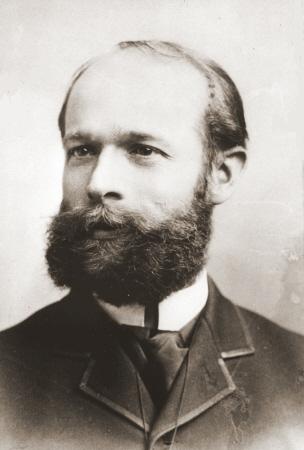
John Lindsay McCutcheon (1857-1905)
6218. Tarrasch and the gods
Still on the subject of Fischer’s My 60 Memorable Games, in a note at move 12 in Game 2 Tarrasch was quoted: ‘Before the endgame the gods have placed the middle game.’ It is indeed one of the German master’s best-known phrases, and we note in his writings two occurrences of the original German (‘Aber vor das Endspiel haben die Götter das Mittelspiel gesetzt’):
1) Note to 30 Qxa7 in Wolf v Tarrasch, Monte Carlo, 1903, in the Berliner Lokalanzeiger, reproduced on pages 111-112 of the April-May 1903 Wiener Schachzeitung;
2) Note to 12...Bf6 in Maróczy v Tarrasch, Ostend, 1905 in the Berliner Lokalanzeiger, reproduced on pages 275-276 of the September-October 1905 Wiener Schachzeitung.
Both games were included in Tarrasch’s book Die moderne Schachpartie (various editions), and the ‘gods’ remark thus appears twice. Below are the passages on pages 96 and 356 of the fourth edition (Leipzig, 1924):
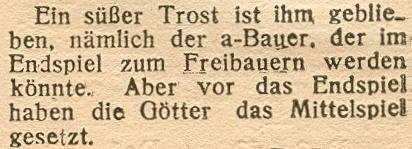

6219. Consultation crosstable
A curiosity from page 188 of the June 1906 Deutsche Schachzeitung is the crosstable of a consultation tournament:
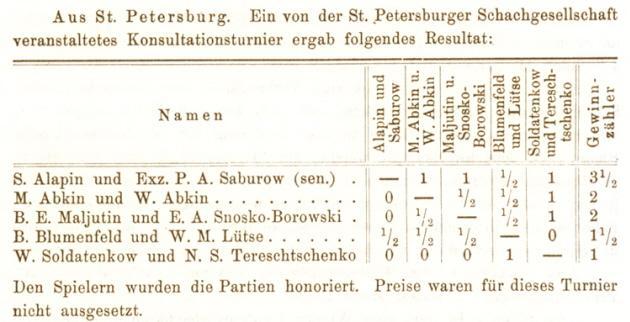
6220. Advertisement
Alan O’Brien (Mitcham, England) asks for information about a product advertised on page xi of the September 1985 BCM:
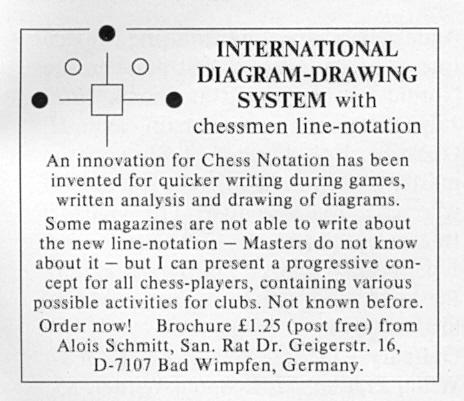
6221. Postage stamps (C.N. 6199)
From our collection, another postage stamp (Mozambique, 2002) featuring Capablanca:
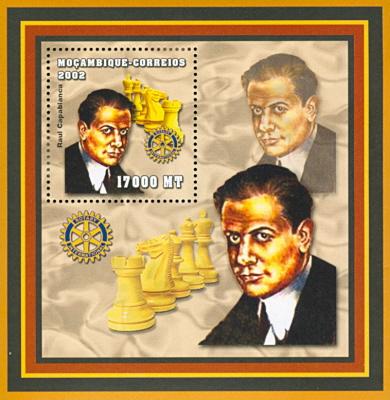
Does any reader have a tally of how often various leading masters have appeared on stamps?
6222. Grover (C.N. 6212)
Russell Miller (Camas, WA, USA) points out that the ‘Find a Grave’ website has an entry providing information on Kenneth Maurice Grover (10 May 1908-6 September 1993). The claims there include ‘He was a GM chessplayer’ and ‘Playing both checkers and chess Mr Grover once played 80 opponents simultaneously’.
From Frederick S. Rhine (Park Ridge, IL, USA) comes the information that Grover’s name is not on any of the first USCF rating lists published in Chess Life (1950-53).
Apart from a few brief mentions of his 1941 book Chess, we have found only one reference to Grover in Chess Review, on page 197 of the November 1934 issue:
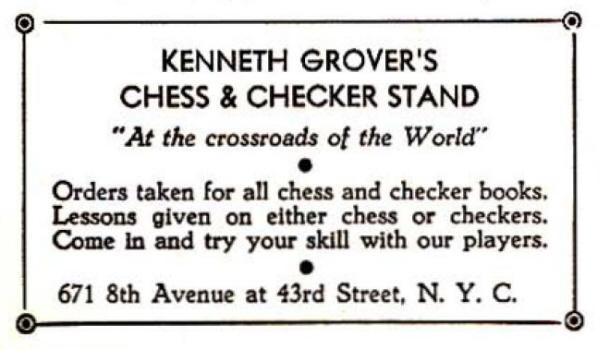
6223. Observations by Reinfeld
‘The most devastating win ever achieved against a grandmaster’ was Fred Reinfeld’s description of the 12-move game Zukertort v Anderssen, Berlin, 1865 on pages 10-11 of Relax with Chess (New York, 1948). On pages 54-55 he called the 17-move game Flamberg v Důras, Abbazia (Opatija), 1912 ‘perhaps the most complicated contest of its length that has ever been played’.
A remark on page 124 also surprised us:
‘It was left for the brilliant young Breyer to pronounce that the first move was a disadvantage, presumably on the ground that White has to commit himself.’
Breyer’s alleged ‘last throes’ remark, it will be recalled, concerned White’s position after 1 e4.
6224. Mr and Mrs Piatigorsky (C.N. 6200)
A number of readers have indicated game-scores in databases, but no games printed in publications of the time have yet been mentioned. The search continues.
6225. Line-up (C.N. 3956)
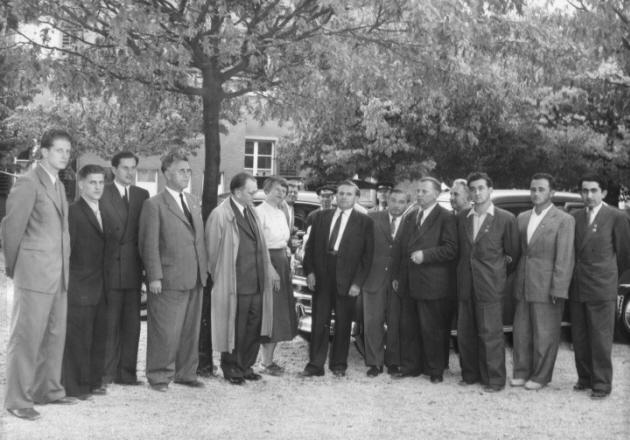
Regarding this photograph taken during the 1953
Candidates’ tournament in Neuhausen and Zurich we are
informed by Grzegorz Siwek (Warsaw) that the figure on
Kotov’s left is D. Postnikov.
The latest key is thus: Averbakh, N.N., Keres, N.N., Perret, N.N., N.N., Kotov, Postnikov, N.N., Taimanov, Geller and Petrosian.
6226. Faber and Faber (C.N. 6214)
C.N. 6214 quoted complaints by Fischer, dated 8 July and 6 August 1999, that the 1988 Faber and Faber edition of My 60 Memorable Games changed an annotation from ‘winning the two Bishops’ to ‘winning the Bishop’s pawn’.
He gave no further particulars, but we see that the comment in question concerns move eight in Gudmundsson v Fischer, Reykjavik, 1960 (Game 19, page 129).
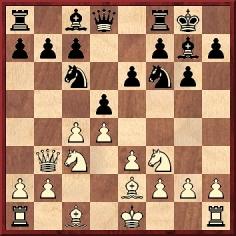
Black has just played 7...Nc6, and the first sentence of Fischer’s original note to 8 Qc2 reads:
‘Probably best (Black threatened ... N-QR4 winning the two Bishops).’
The Faber and Faber edition mentioned by Fischer falsified the note by putting:
‘Probably best (Black threatened ... N-QR4 winning the Bishop’s pawn).’
C.N. 4867 reported that there exist two editions of the black-cover Faber and Faber volume, and for simplicity’s sake they are referred to here as ‘Black 1’ and ‘Black 2’. Their front covers are identical, but the respective back covers are:
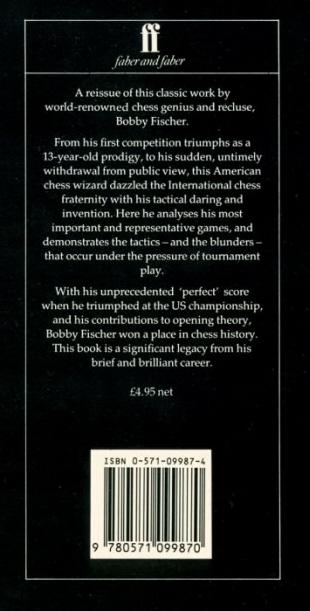
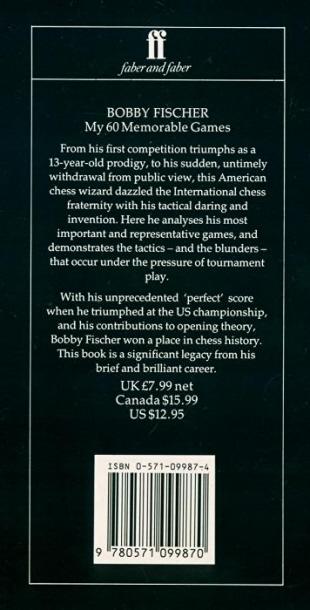
‘Black 2’ introduced the textual change in the Gudmundsson v Fischer game.
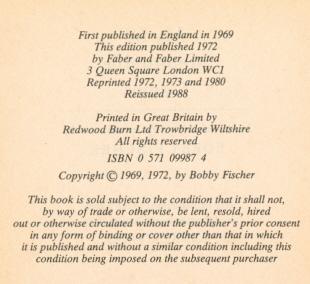
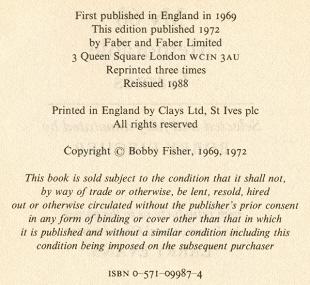
Above are the respective imprint pages of ‘Black 1’ and
‘Black 2’. Whether both editions were indeed published
in 1988 is unclear, given that the UK price of ‘Black 2’
was 60% higher. It will be seen, in particular, that
there was a change of printer, as well as, on the
imprint page of ‘Black 2’, a misspelling of Fischer’s
name.
In the Gudmundsson v Fischer game, the 1995 Batsford edition, for its part, made one of its characteristic little alterations: ‘Probably best (Black threatened ...Na5 gaining the two bishops).’
6227. Georg Marco’s brother
Olimpiu G. Urcan (Singapore) points out that page 180 of Johann Berger’s Schach-Jahrbuch für 1899/1900 (Leipzig, 1899) had an entry for Michael Marco, Georg Marco’s brother, who was born in Czernowitz (now Cernăuţi in Romania) in 1876:
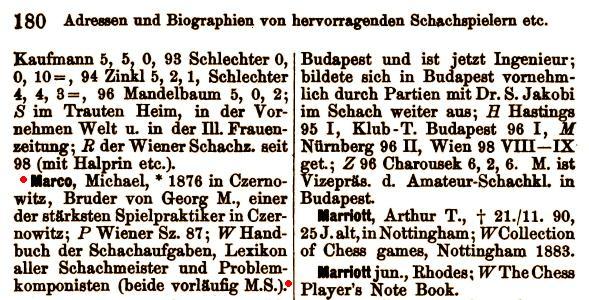
Our correspondent notes too that some of Michael Marco’s original chess problems were published in the Wiener Schachzeitung, including the following on page 156 of the July 1900 issue:
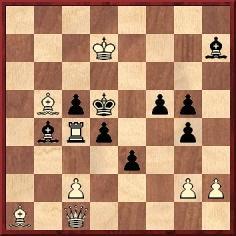
White mates in four moves
Mr Urcan has also supplied the following games:
Michael Marco – HailigCafé l’Europe, Czernowitz, 23 January 1896
Evans Gambit Accepted
1 e4 e5 2 Nf3 Nc6 3 Bc4 Bc5 4 b4 Bxb4 5 c3 Ba5 6 d4 exd4 7 Qb3 Qe7 8 O-O Bb6 9 cxd4 Nxd4 10 Nxd4 Bxd4 11 Nc3 c6 12 Ba3 Qf6 13 e5 Qg6 14 Rad1 Bb6
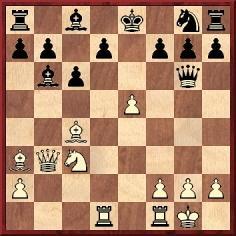
15 Nb5 Nh6 16 Nd6+ Kd8 17 Bxf7 Qg5 18 Nxb7+ Bxb7 19 Rxd7+ Kxd7 20 Qe6+ Kc7 21 Qd6+ Kc8 22 Be6 mate.
Source: Wiener Schachzeitung, January 1901, pages 18-19.
Michael Marco – J. SalterCzernowitz, October 1898
Scotch Gambit
1 e4 e5 2 Nf3 Nc6 3 d4 exd4 4 Bc4 Bc5 5 c3 dxc3 6 O-O cxb2 7 Bxb2 Bf8 8 e5 d6 9 Qb3 Nh6 10 Re1 Ne7 11 exd6 cxd6 12 Na3 a6
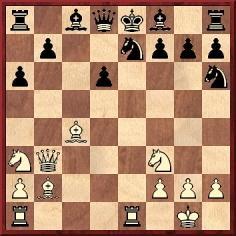
13 Rxe7+ Kxe7 14 Re1+ Kd7 15 Bc3 b6 16 Bd5 Ra7 17 Ba5
bxa5 18 Qa4+ Kc7 19 Qxa5+ Kd7 20 Bc6+ Resigns.
Source: Wiener Schachzeitung, October 1898, page 168.
Michael Marco – MelzerCzernowitz, October 1900
King’s Gambit Accepted
1 e4 e5 2 f4 exf4 3 Nf3 g5 4 Bc4 Bg7 5 h4 h6 6 d4 d6 7 hxg5 hxg5 8 Rxh8 Bxh8 9 Nc3 c6 10 Ne5 dxe5 11 Qh5 Qf6 12 dxe5 Qg7 13 e6 Nf6 14 exf7+ Kd8 15 Qxg5 Nd7 16 Bxf4 Qxg5 17 Bxg5 Kc7 18 e5 Nh7 19 e6 Bxc3+ 20 bxc3 Nb6
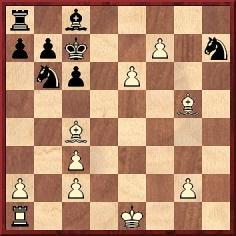
21 O-O-O Nxc4 22 Bd8+ Kb8 23 e7 Resigns.
Source: Wiener Schachzeitung, January 1901, pages 17-18.
What more can be discovered about Michael Marco?
6228. Spot the master (C.N. 6216)
From page 182 of the December 1922 American Chess Bulletin:
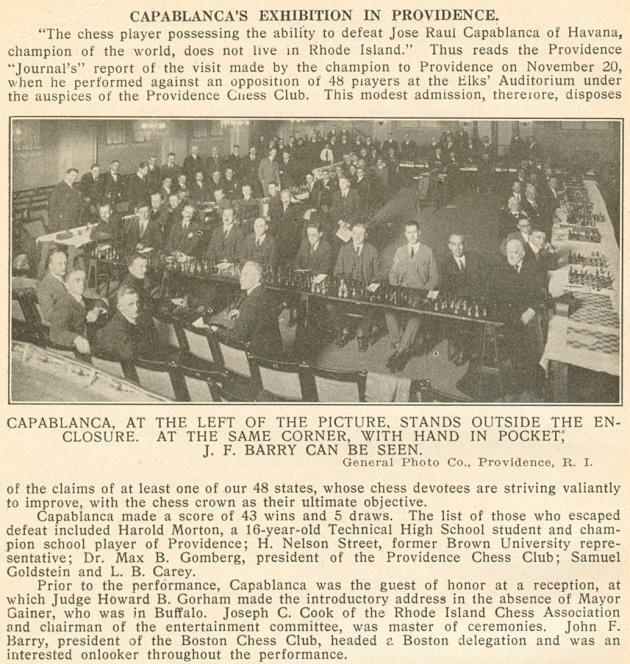
Larger version of the photograph
6229. Grover (C.N.s 6212 & 6222)
Is there a checkers expert who could kindly provide a general assessment of Kenneth M. Grover’s level of expertise in that game?
Our collection contains two copies of Twentieth Century Checkers inscribed by Grover:
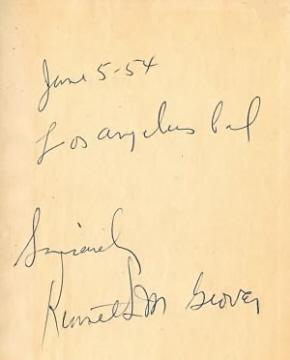
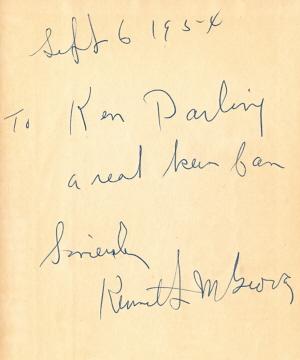
6230. Faber and Faber (C.N.s 6214 & 6226)
Luc Winants (Boirs, Belgium) points out another black-covered edition of Fischer’s My 60 Memorable Games:
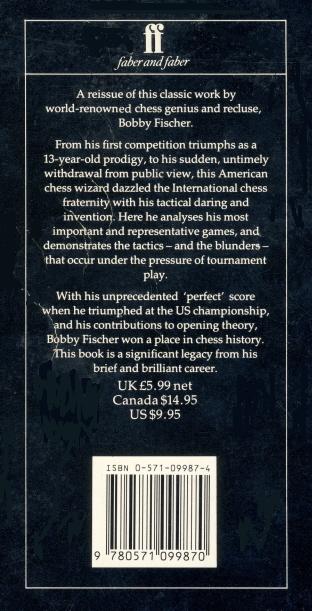
Although the prices place this edition second in the series of the three now known, the imprint page, with its references to 1989 and 1990, gives the impression that it came third:
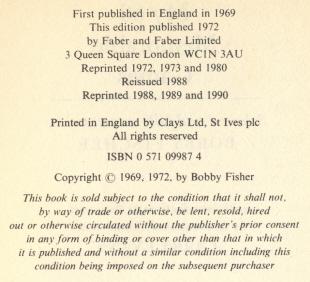
With regard to the Bertok and Gudmundsson games, this edition has the same textual changes as ‘Black 2’.
6231. Georg Marco’s brother (C.N. 6227)
Regarding the birth-place of Michael Marco, we have received the following from Willibald Müller (Munich, Germany):
‘The city of Czernowitz now belongs to Ukraine and no longer to Romania.’
Acknowledging the correction, Olimpiu G. Urcan (Singapore) writes:
‘My formulation in brackets – if necessary at all – should have been “(Cernăuţi in the Romanian language)”, since Georg and Michael were of Romanian origin, or – even simpler – “(now Chernivtsi in Ukraine)”.’
Mr Urcan also notes that page 142 of an earlier (1892/93) edition of Berger’s Schach-Jahrbuch than the one mentioned in C.N. 6227 gave Michael Marco’s birth-place as Trieste:
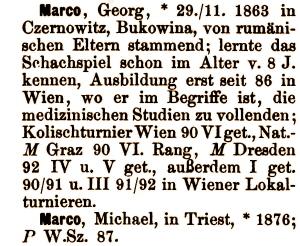
6232. Capablanca and Réti
A further contribution from Mr Urcan is this page
from Das interessante Blatt of 26 March 1914:
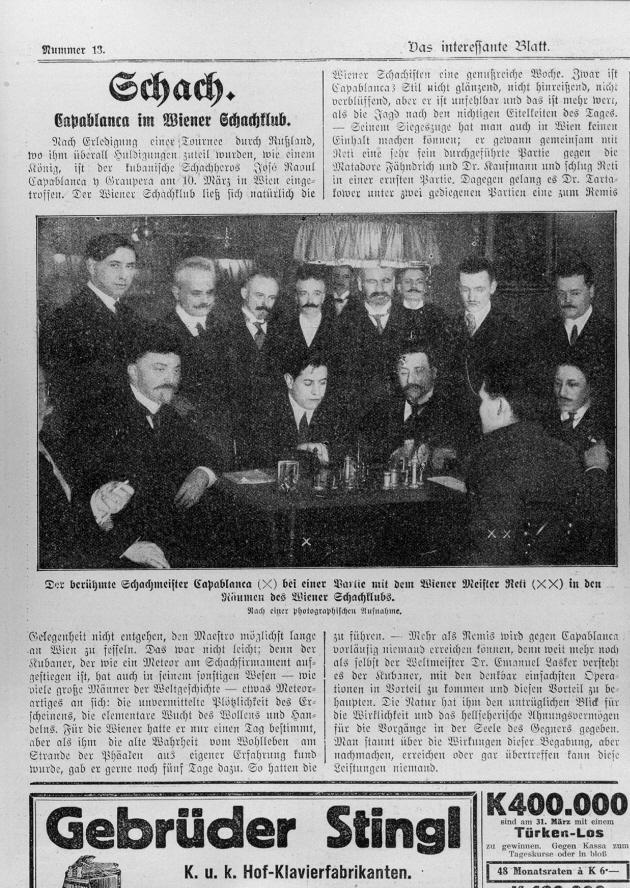
Concerning Capablanca’s play in Vienna against Réti, as well as Fähndrich and Kaufmann, in 1914 see page 72 of our book on the Cuban. The game-scores were given in The Unknown Capablanca by David Hooper and Dale Brandreth (London, 1975).
Mr Urcan asks whether it is possible to identify any of the other players in the photograph. In particular, is Arthur Kaufmann there? Our correspondent informs us that he has Kaufmann’s death certificate and will, which show that he died in 1938, and not circa 1940 as given in Jeremy Gaige’s Chess Personalia.
6233. Bad Pistyan, 1912
Another reader to send in a rare photograph is Jan Kalendovský (Brno, Czech Republic):
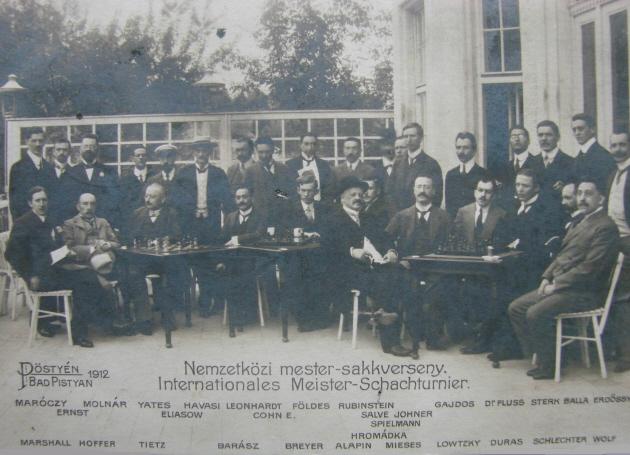
For a slightly different group shot, see C.N. 3447.
6234. Sultan Khan
Tony Gillam (Nottingham, England) sends a report on page 8 of the Daily News (London), 12 August 1929 headed ‘The new chess champion’:
‘Hafiz Mian Sultan Khan, the new British chess champion, the first Indian to achieve this distinction, was “discovered” by Colonel Malik Nawab Sir Umar Hayat Khan Tiwana, who is solely responsible for bringing him to England.
Sultan Khan, who is 24, is the son of a religious leader in the Punjab. He has nine brothers, all advanced chessplayers, having profited by the teachings of their father. Sir Umar Hayat Khan Tiwana took a great interest in Sultan Khan because of the marvellous aptitude he showed, and organized a special All-India Tournament, in which Sultan came out at the head. Sultan does not speak English, and cannot read any book on chess, so Sir Umar engaged an English tutor to teach Sultan the English moves of the game.’
Sultan Khan
Our correspondent asks if Sultan Khan’s exact date of birth is known. The best reference that we can cite is from H. Meek on page 337 of the September 1929 BCM:
‘Concerning the career of the new champion, I am indebted to his friend, Syed Akbar Shah, for the following information.
M. Sultan Khan was born in 1905 in the village of Mittha Tawana in the Sirgoodha district of the Punjab. He learnt the game [Indian chess] at the early age of nine from his father, who was a very strong player.’
6235. Georg Marco’s brother (C.N. 6231)
Erwin Huber (Munich, Germany) suggests – and we agree with him – that Trieste referred not to Michael Marco’s birth-place but to where he was living at the time the Schach-Jahrbuch was written.
6236. Capablanca and Réti (C.N. 6232)
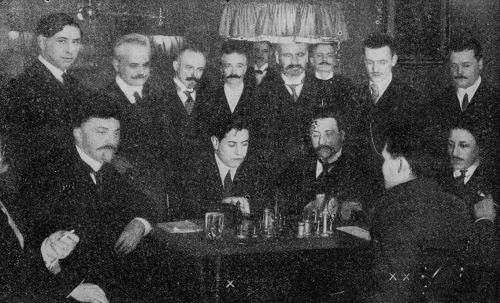
Mr Huber also notes that when the Capablanca v Réti photograph appeared opposite page 81 of Ernst Franz Grünfeld by Michael Ehn (Vienna, 1993) the man standing second from the right was identified as Grünfeld.
6237. Reprints (C.N.s 3586 & 5464)
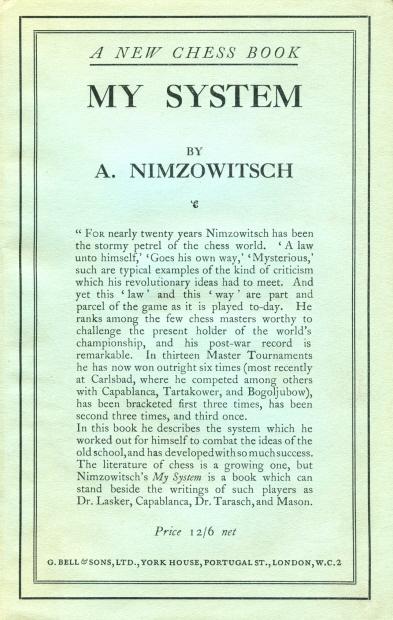
Dust-jacket front (1929)
Nimzowitsch’s My System was first published by G. Bell and Sons, Ltd. in 1929 (302 pages), and the company also issued a two-page errata list. Some, though not all, of the corrections were included by Bell many years later in a reset version (265 pages).
In 1987 B.T. Batsford Ltd. chose to reprint the 1929 original, but the company’s then ‘Adviser’, Raymond Keene, did not realize this. He added a Foreword (‘Batsford are proud to present this new edition ...’) which mentioned page numbers corresponding to the other Bell edition. The Batsford reprint furthermore revealed ignorance of the errata list.
In 2003 Hardinge Simpole brought out a reprint of My System, though it was nothing more than an expensively priced, cheaply produced, reprint of the Batsford reprint, still with ignorance of the errata list, still with the mix-up over the page numbers and, even though Batsford’s name was not mentioned elsewhere, still with Mr Keene’s remark ‘Batsford are proud to present this new edition’.
How pride can come into any of this is unclear.
6238. Grandmaster inflation
‘All agree the grandmaster title suffers from inflation and so has lost much of its value. The FIDE awards the title too readily and on conditions known in advance. So agreements are made in the corridors: “Help me and I will help you ...” The practice is irregular and needs correction.’
Criticism of ‘grandmaster inflation’ is frequent, but the above passage was written 44 years ago. The author was Petar Trifunović, on page 202 of Chess Review, July 1965.
6239. Capablanca v Black
Jeremy Silman (Los Angeles, CA, USA) asks about the circumstances of Capablanca’s loss to Roy T. Black at New York in 1911 (a Sicilian Wing Gambit).
Contrary to appearances, the game was played, on 25 January 1911, in a serious event: the national tournament in New York. From page 50 of the March 1911 American Chess Bulletin:
‘Capablanca lost only one game, in the fourth round, when he was opposed to R.T. Black, of Brooklyn. Against him, Capablanca, before he had really settled down to serious work, played a gambit variation of the Sicilian Defense, a course he had reason to regret. It was surprising to find Capablanca, after six games, with a score of 3½ to 2½, yet such was the case and it required six successive wins in the remaining rounds to enable him to get as close to Marshall as he did.’
The same issue (pages 56-57) had the game against R.T. Black, with annotations by Walter Penn Shipley:
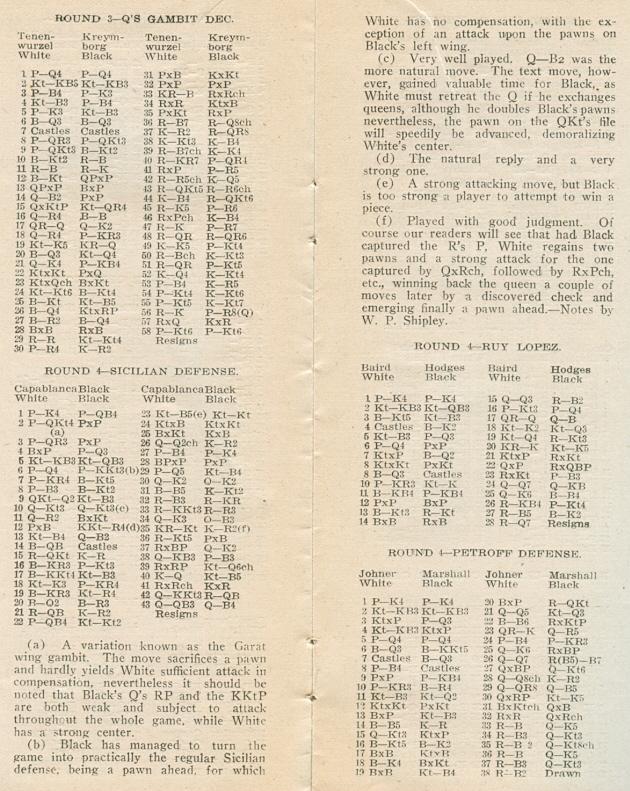
Among the few books to have annotated the game are Capablancas Verlustpartien by Fritz C. Görschen (Hamburg, 1976) and the first volume of the ‘Chess Stars’ anthology on Capablanca (Sofia, 1997).
The Cuban, for his part, gave this account towards the end of Chapter IV of My Chess Career (London, 1920):
‘In the winter of 1910-1911 I made another tour of the US. A tournament was arranged in New York, which I entered with the idea of practising for the coming tournament at San Sebastian. The New York tournament started in January. I rode on a train 27 hours straight from Indianapolis, the last city of my tournée, to New York. I arrived at nine in the morning and had to start at eleven the same day, and play every day thereafter. I was so fatigued that I played badly during the first part of the contest. Half of it was over and I was yet in fifth place, though the only opponent of real calibre was Marshall. I finally began to play better, and by winning five [six, in fact] consecutive games finished second to Marshall.’
6240. Santasiere book
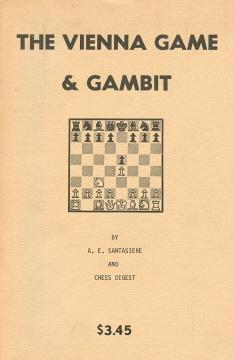
Leafing through The Vienna Game & Gambit by A.E. Santasiere and Chess Digest (Dallas, 1974), we became acquainted with such players as Bodin, Bogatzrtschuk, Bogolgubov, Charovsek, Golombeck, Hampoe, Hartson, Mettner, O’Kelley, Pincus, Polugaousky, Schallop, Schiffeis, Spielman, Stork, Sxabo and Weenimk. There are also instances of Adam’s, Barne’s and Schiffer’s, as well as the places Barman, Cortmund and Edinburg. Page 14 refers to a game between Mieses and Chigorin whose occasion was ‘Monte Car10 1002’, and page 70 discusses the game ‘Alekhine and Nenarokov-Bernsten and Blumfield, Moscow 1964’.
6241. Campbell-Bannerman (C.N. 6070)
C.N. 6070 requested a proper source for the remark ascribed to Sir Henry Campbell-Bannerman, ‘Chess is not a game but a disease’. We now see that on page 184 of the July 1957 BCM D.J. Morgan mentioned a passage on page 57 of volume two of The Life of The Right Hon. Sir Henry Campbell-Bannerman, G.C.B. by J.A. Spender (London, 1923). It was the final paragraph of ‘certain reminiscences supplied by Mr Henry Higgs’:

6242. Different views
From Solitaire Chess by I.A. Horowitz (New York, 1962):

From page 17 of Why You Lose at Chess by F. Reinfeld (New York, 1956):
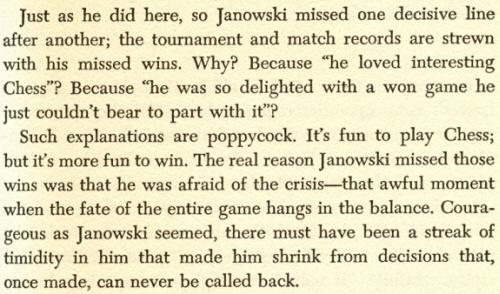
Other quotes on this theme will be welcomed.
| First column | << previous | Archives [60] | next >> | Current column |
Copyright: Edward Winter. All rights reserved.
